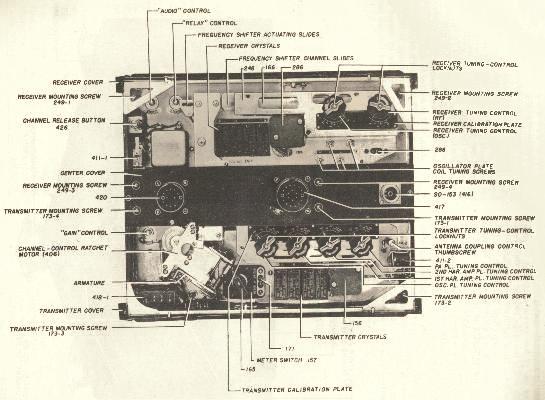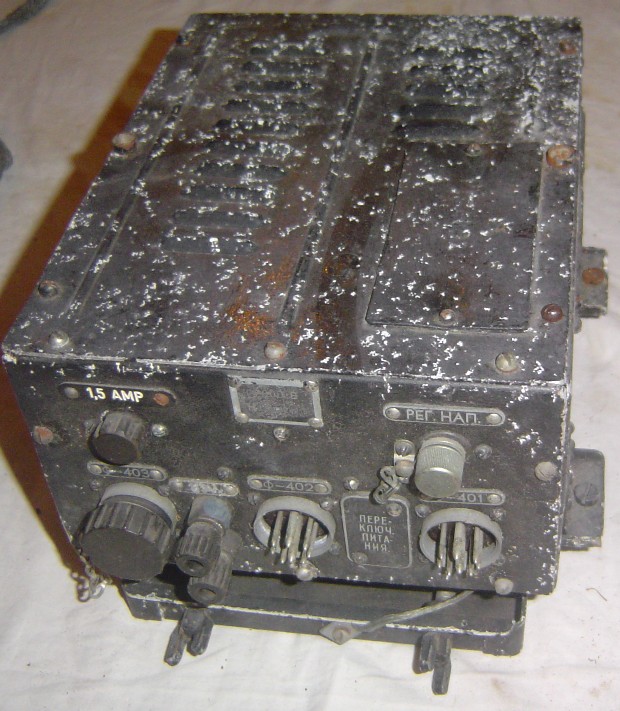
SCR-522. Receiver at top and Transmitter below. The channel-control ratchet motor for re-setting
the channels can be seen at lower left as well as the pre-set tuning knobs on the right.
| VK2DYM'S MILITARY RADIO AND RADAR INFORMATION SITE. |
RUSSIAN TYPE P-800 VHF MILITARY AIRCRAFT RADIO.
Older ex-service radiomen and collectors of military radio equipment will know of the English TR-1143 VHF aircraft transceiver, which was adapted by the US military as the SCR-522 and then became the TR-5043, used extensively by the allies in the latter stages of WW2 and up to the 1950's, in Spitfires, Mustangs and other aircraft of that vintage. After the war many amateurs modified the sets for 2 meters and it provided a cheap entry to that amateur radio band.
The TR-5043/SCR-522 was a 4 channel crystal controlled, amplitude modulated transmitter and receiver, covering the 100-156 Mhz range and operated remotely via a 4 button switch (BC-602). The power output was less than 10 watts (from 320 watts input!). The transmitter (BC-624) and receiver (BC-625) were separate units which fitted side-by-side into a metal case (CS-80), whilst the channel change and tuning actuator mechanism was in the form of a small rack mount (FT-144) and fitted into the case on top of the two units. The channel change mechanism was electromechanical with a uni-selector relay that selected the required crystals and moved four pre-set metal slides to retune the receiver input and transmitter output circuits. The transmitter has four tuned circuits whilst the receiver has two. Before each mission the correct crystals were fitted and the set was pre-tuned for each channel. The separate power supply (PE-94A) was a very heavy (19 Kg) genemotor in a metal case with filters etc. Most sets had a 28 volt input, although 14 volt versions were made. The photo below shows the top view of a SCR-522 with the lid removed.

SCR-522. Receiver at top and Transmitter below. The channel-control ratchet
motor for re-setting
the channels can be seen at lower left as well as the pre-set tuning
knobs on the right.
Some while ago a Russian Type P-800 transceiver was obtained from a Polish made MiG-15 two seater fighter/training aircraft (serial No. 607) that was imported into Australia. The radio turned out to be a Russian/Polish made version of the SCR-522 and it is interesting to compare the two. Electrically the set is very similar to the SCR-522 but with Russian valves and electrical components. However, the channel change mechanism and many other components are obviously American made or exact copies! The explanation for this is that during the war, the US supplied the Russians with large quantities of equipment and materials and that must have included the components of the SCR-522, which they have built into a modified version of the US set.

The Russian radio consists of three separate boxes, a transmitter unit "A" and a receiver unit "B" as shown above, plus a power control unit "C". Power for the set comes from the main Power Unit for the aircraft. Whereas the SCR-522 only required two major connecting cables, plus co-ax antenna socket, the Russian set requires a number of interconnecting cables.
The electrical connectors on the units are different to the US type and all nameplates are in Polish. The rubber shock mounts of the Russian set are not to US or British dimensions. The construction is quite good, but the cases are of lighter aluminium construction than the SCR-522 and exhibit a few dents from mishandling.
The channel control box is fitted on the upper left side of the cockpit and is a 4 button unit very similar to the SCR-522 control box but with larger buttons.
It appears that the set stayed with the aircraft because it is painted with the aircraft serial 607, whereas the allies swapped faulty equipment with replacements from a service pool. Although the cases show a few dents, they are in very good condition for 50 year old radio sets. Maybe the penalty for careless abuse was more than a slap on the wrist! Note that there are separate SO-239 co-axial connectors for the antenna on each unit, and there was a remote antenna switching relay locate near the antenna.

This photo shows the Transmitter with the front cover removed so that the channel change and tuning mechanism can be compared with the SCR-522. Notice how it has the same uni-selector on the top left which operates metal levers to rotate the tuning capacitors. The levers are preset via the knurled knobs shown at top centre. This transmitter only has three tuning adjustments whereas the SCR-522 transmitter has four. Just below the three tuning dials you can see the four cylindrical crystals, channel A84, A361, etc. Notice too the co-ax sockets on the right side. Tx/Rx switchover and Antenna switching was done by a remote relay.

The receiver shown above has its own channel changer/tuning slide, again a SCR-522 component, and it has the same volume and relay controls as the American radio.
Whereas the SCR-522 was only fitted with four sets of crystals as needed, the Russian set has a metal box, with a hinge and spring clip, attached to the top of each unit, containing a tray with a full complement of 50 crystals. The crystals are fitted inside cylindrical holders about the size of a 35mm film container and marked "A" for the transmitter and "B" for the receiver, each with the channel number marked. Here the metal box is partly raised and the tray with crystals is on the left.

This is a photo of the top of the receiver and shows the neat construction with both metal and glass construction valves ("lampy" in Polish). The component designations and values are all in English. The RF stages are on the right and the IF stages on the left. The Polish instructions mention “LAMPY”(valve) 6G2 and 6K4. On the top right corner of the chassis “Gora” has autographed the set.

An underneath view of the receiver with the RF section on the left. Wiring is neat and tidy.

A top view of the transmitter with the RF section on the right. Note the output power valve on the bottom left with the output circuitry above it.

Here we see the base of the power valve on the left whilst the driver valve is reversed and on the right. Both valves are equivalent of the 832.
There are obvious differences in part location and component dimensions but the similarities are such that radio technicians who worked on the SCR-522 set would feel right at home with this gear.
The Russian set appears to have a similar output power to the SCR-522, but
the power supply "C" is a marked contrast to the heavy US set, in that
it contains filters and relays and weighs only around 10 Kg. It is a
small black box about 250mm square by 150mm high and
derives its input from a separate large genemotor which supplies other
accessories.
View of the power Supply unit.
The MiG-15 and it's bigger, faster successor, the MiG-17, as well as other Soviet aircraft of the era, all carried this model VHF radio as well as a low frequency Direction Finding radio which is based on the Bendix MN-26 radio made in the US commencing in the late 1930's and running well into the 40's. There are a few differences in construction technique and the Polish wording indicates it's origin but it is otherwise almost an exact copy of the MN-26. The frequency control box, which is very like the Bendix MN-28 controller, is located on the upper right sidewall of the cockpit. Whereas the VHF radio does not comply with current Australian air communications standards and has been replaced by a transistorised transceiver, the MN-26 type radio performs better than modern solid state models so has been retained in aircraft 607. In Australia several Polish Iskra two seat trainers and a MiG-21 all had the Type 300 VHF set and the MN-26 copy.
Another interesting comparison between east and west is the engine of the MiG-15 which is a copy of the Rolls Royce Nene jet engine. The English Government sold 25 Nenes to the Russians in 1946 and the design was promptly copied (illegally) and improved. When working on the engine of this MiG the English Rolls Royce manuals proved very adequate for the purpose! The MiG-15 first flew in 1947 and several thousand were made in various variants with many still in service. The Polish made aircraft were mostly 2 seat trainer MiG-15UTI models, called the LIM-3 in Poland. (No. 607 is a LIM-3) It has a wing span and length of 10 meters, and a top speed of 1000 Km/hr, with armament of a single 23 mm cannon. The MiG-15 gave the United Nations forces in Korea a rude shock as it was superior in many ways to the allied aircraft including the F-86 Sabre jet, but fortunately the Chinese pilots were not as well trained and inexperienced.
Postscript. A number of MiG15's and MiG17's were imported and sold in Australia and several were restored to flying status. Now it appears that the Polish airworthiness documentation was forged and they are well past their use by date. Civil and criminal actions are pending.
Please note, this article is copyrighted.